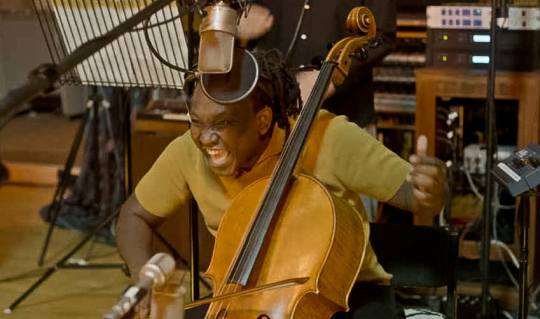|
In the past year I’ve seen two concerts by South African cellist/singer Abel Selaocoe (pronounced ‘sel-AU-chay’), who’s becoming deservedly celebrated here in the UK. Each was an absolute tour-de-force.
Here’s what I wrote, excitedly, on social media about them at the time: "There was a long standing ovation at a sold-out Queen Elizabeth Hall in London yesterday for the brilliant Abel Selaocoe - cellist, singer, composer, improviser, performer, a shining light in bridging between western classical, African and improvising music - in the final show of the tour in collaboration with his trio and the string players of the Manchester Collective. Inspiring, indeed awe-inspiring, and liberating; made me want to rush home and play.” (There’s a link to a video of the whole concert below.)
And later, "Another fine Abel Selaocoe concert at the Queen Elizabeth Hall last night. And the audience sang beautifully. He’s currently artist-in-residence at the QEH, and doing concerts there every couple of months or so, each a different project. This one was the premiere of his debut album, Where Is Home (Hae Ke Kae).”
Now I have the album, and it is as good as I had hoped.
The opener “Ibuyile iAfrica” (‘Africa is Back’ in the isiZulu language) is his arrangement of, as he explains in the notes, ‘a traditional hymn that was sung in apartheid times about the struggle to conquer that regime.’ It begins with a trickle of cello harmonics (joined on the track by fellow-cellists Yo-Yo Ma and Colin Alexander) and piano, firming up to lyrical bowing before his warm voice enters, joined by a vocal trio, and the hymn surges in glorious harmony, through which the cellos rise and keen before improvising in trio until his voice, and then all the vocals and cellos, rise together in rich chorus.
“Dipoloelo” (‘Recite’) a brief cello solo improvisation, leads into the powerful, “Zawose,” a tribute to Tanzanian traditional musician Hukwe Zawose in which Selaocoe translates the spirit and pulse of the one-string Tanzanian stick-zither zeze to the cello. His voice soars, orates, and growls Mahlathini-like, joined in exuberance by the three vocalists and full band of violins, viola, cello, electric bass and hand-percussion including calabash, djembe, talking drum and congas.
Zawose, Asanti sana
Re leboha ba Tanzania
Ka ho Thusa Africa Borwa ka nako e Thata
Tsela ya badimo E Tshweu
|
Zawose, thank you in abundance.
We honor those from Tanzania
Helping South Africans in the time
of struggle
The path paved by our ancestors is radiant
|
Making absolute sense and a natural sequence, next come the four parts of 17th-century Italian composer Giovanni Benedetto Platti’s “Cello Sonata No.7 in D,” played by a distinctly unusual quartet of Selaocoe’s cello, Elizabeth Kenny’s theorbo (very long-necked lute), Fred Thomas’s double bass and Kadialy Kouyate’s kora, with short improvisations from the individual instruments between the movements; as Selaocoe points out, improvisation was a part of baroque music and also of that of the griots of West Africa.
Four original songs follow, in the Sesotho language of Lesotho. “Hlokomela” (‘Take Care’) is a gorgeous song of calm voice, serenely bowing cellos and the slow deep pulse of Sidiki Dembele’s calabash. “Qhawe” (‘Hero’) is urgent, his vocal moving between high declamation and guttural growl matched by fast chunky bowing and percussion. In the anthemic “Lerato” (‘Love’) his voice caresses in a song he describes as reflecting the sound world of South African hymn singing with which he is familiar. “Seipone” (‘Mirror’), just voice and improvising cello, begins with declamatory vocal, into pattering bowed-harmonics, then keening high bowing over a plucked percussive pattern. It flows organically into a Sarabande from “Bach’s Cello Suite No.3 in C,” in which as he plays the Bach piece he sings a countermelody in the way that his mother did as she sat and sewed while he practised.
Churning strings and Mamadou Sarr’s talking drum in the brief “Invocation” explode into the high-energy full-band stabbing and wild bowing of “Ka Bohaleng,” its title referring to the Sesotho saying of a woman ‘holding the knife on the sharp side,’ the strong mother raising the children while the father went out to work. A short Bach sarabande on solo cello, then the massed, criss-crossing vocals of Selaocoe, in a percussion-accompanied prayer and ending, joined by his family in a verse from a hymn.
Magnificent, world-class, and a musical culture-bridging beacon.
Find out more about the artist on his web site.
|
